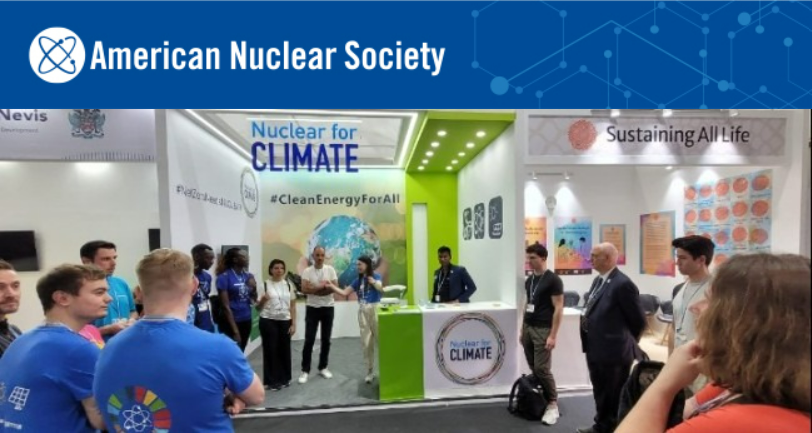Energy secretary Jennifer Granholm (in purple blazer) and the ANS-sponsored delegates pose in front of the Nuclear for Climate booth at COP27.
Nuclear energy is no longer on the fringes of the international climate conversation. At COP27, the United Nations climate change conference held in Sharm el-Sheikh, Egypt, from November 6 to 18, pronuclear advocates were everywhere—and they were talking to everyone. They populated the International Atomic Energy Agency’s #Atoms4Climate pavilion, the first-ever nuclear pavilion in the 27-year history of the negotiations. Echoing such strong representation, the final statement issued by the conference used language that included nuclear power.
U.S. special envoy for climate John Kerry at COP27. (Photo: Embassy of Ukraine in the United States of America)
U.S. special envoy for climate John Kerry and Ukraine’s minister of energy German Galushchenko have announced a two-to-three-year pilot project aimed at demonstrating the commercial-scale production of clean hydrogen and ammonia from small modular reactors in Ukraine using solid oxide electrolysis.
From left: Romanian minister of energy Virgil Popescu, U.S. Export-Import Bank president and chair Reta Jo Lewis, Romanian president Klaus Iohannis, U.S. special presidential envoy for climate John Kerry, and U.S. State Department assistant secretary Geoffrey Pyatt. (Photo: ExIm)
The Export-Import Bank of the United States has issued two letters of interest (LOIs) for the financing of U.S.-sourced pre-project technical services in connection with the proposed reactor construction project at Romania’s Cernavoda nuclear plant, the bank announced last week.
Scheduled to appear at the Energy Security panel session at COP27: from left, moderator Sweta Chakraborty and speakers Kathryn Huff, Seth Grae, and Bonnie Jenkins.
The United Nations’ COP27 conference, held this year in Sharm el-Sheikh, Egypt, from November 6 to 18, will feature the panel discussion “Energy Security” on Tuesday, November 15, at 9:00 a.m. EST (4:00 p.m. local time). The discussion is being sponsored by the review platform We Don’t Have Time; the live stream will be available to viewers on their COP27 Climate Hub website.
The U.S. ITER Project Office in Oak Ridge, Tenn. U.S. ITER has received $256 million in Inflation Reduction Act funding. (Photo: U.S. ITER)
Just days before COP27 and the U.S. midterm elections, the White House announced $1.55 billion in Inflation Reduction Act (IRA) funding for national laboratories and the launch of a Net-Zero Game Changers Initiative based on a new report, U.S. Innovation to Meet 2050 Climate Goals. Out of 37 research and development opportunities identified, fusion energy was selected as one of just five near-term priorities for the new cross-agency initiative. Together, the announcements signal policy and infrastructure support for fusion energy—the biggest chunk of Department of Energy Office of Science (DOE-SC) IRA funding went to ITER, via Oak Ridge National Laboratory—and for advanced nuclear technologies to power the grid and provide process heat to hard-to-decarbonize industrial sectors.
Attendees at the Nuclear for Climate booth during the COP27 conference.
COP27, the 2022 United Nations climate change conference, is under way this week in Sharm el-Sheikh, Egypt. A delegation from the American Nuclear Society has traveled there to participate in Nuclear for Climate’s #NetZeroNeedsNuclear advocacy campaign. Nuclear for Climate, cofounded by ANS, is a grassroots organization made up of nuclear professionals and scientists from over 150 associations worldwide.









.png)
 Released this week in the lead-up to November’s COP27 event in Egypt is a report from the United Nations Economic Commission for Europe,
Released this week in the lead-up to November’s COP27 event in Egypt is a report from the United Nations Economic Commission for Europe,